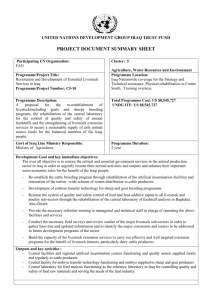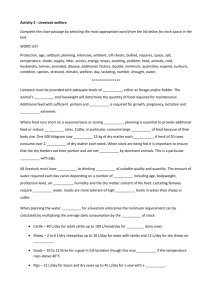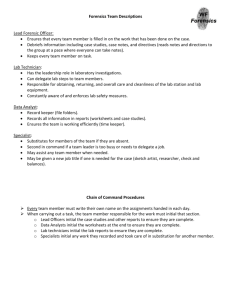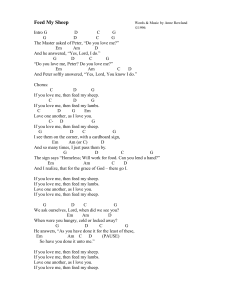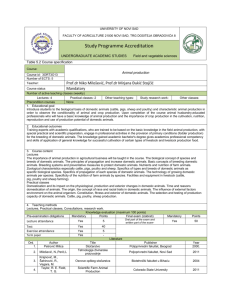Livestock Premises Inspection Guide (must be used with Animal
advertisement
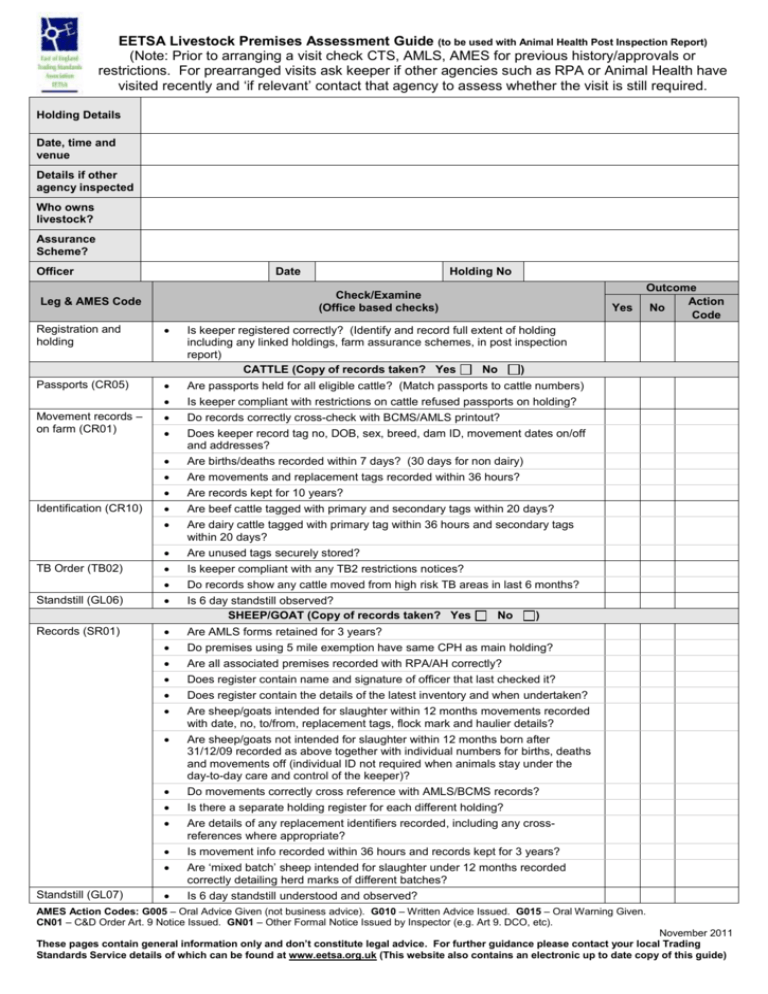
EETSA Livestock Premises Assessment Guide (to be used with Animal Health Post Inspection Report) (Note: Prior to arranging a visit check CTS, AMLS, AMES for previous history/approvals or restrictions. For prearranged visits ask keeper if other agencies such as RPA or Animal Health have visited recently and ‘if relevant’ contact that agency to assess whether the visit is still required. Holding Details Date, time and venue Details if other agency inspected Who owns livestock? Assurance Scheme? Officer Date Holding No Check/Examine (Office based checks) Leg & AMES Code Yes Registration and holding Is keeper registered correctly? (Identify and record full extent of holding including any linked holdings, farm assurance schemes, in post inspection report) CATTLE (Copy of records taken? Yes No ) Passports (CR05) Are passports held for all eligible cattle? (Match passports to cattle numbers) Is keeper compliant with restrictions on cattle refused passports on holding? Do records correctly cross-check with BCMS/AMLS printout? Does keeper record tag no, DOB, sex, breed, dam ID, movement dates on/off and addresses? Are births/deaths recorded within 7 days? (30 days for non dairy) Are movements and replacement tags recorded within 36 hours? Movement records – on farm (CR01) Identification (CR10) TB Order (TB02) Standstill (GL06) Is 6 day standstill observed? SHEEP/GOAT (Copy of records taken? Yes Records (SR01) Are AMLS forms retained for 3 years? Do premises using 5 mile exemption have same CPH as main holding? Are all associated premises recorded with RPA/AH correctly? Does register contain name and signature of officer that last checked it? Does register contain the details of the latest inventory and when undertaken? Are sheep/goats intended for slaughter within 12 months movements recorded with date, no, to/from, replacement tags, flock mark and haulier details? Are sheep/goats not intended for slaughter within 12 months born after 31/12/09 recorded as above together with individual numbers for births, deaths and movements off (individual ID not required when animals stay under the day-to-day care and control of the keeper)? Do movements correctly cross reference with AMLS/BCMS records? Is there a separate holding register for each different holding? Are details of any replacement identifiers recorded, including any crossreferences where appropriate? Is movement info recorded within 36 hours and records kept for 3 years? Are ‘mixed batch’ sheep intended for slaughter under 12 months recorded correctly detailing herd marks of different batches? Is 6 day standstill understood and observed? Standstill (GL07) Outcome Action No Code Are records kept for 10 years? Are beef cattle tagged with primary and secondary tags within 20 days? Are dairy cattle tagged with primary tag within 36 hours and secondary tags within 20 days? Are unused tags securely stored? Is keeper compliant with any TB2 restrictions notices? Do records show any cattle moved from high risk TB areas in last 6 months? No ) AMES Action Codes: G005 – Oral Advice Given (not business advice). G010 – Written Advice Issued. G015 – Oral Warning Given. CN01 – C&D Order Art. 9 Notice Issued. GN01 – Other Formal Notice Issued by Inspector (e.g. Art 9. DCO, etc). November 2011 These pages contain general information only and don’t constitute legal advice. For further guidance please contact your local Trading Standards Service details of which can be found at www.eetsa.org.uk (This website also contains an electronic up to date copy of this guide) Check/Examine (Office based checks) Leg & AMES Code Identification (SR05) Movement Documents (AM02) Movement Records On Farm (PR01) Standstill (GL05) Yes Are sheep/goats tagged by 9 months (6 months if indoors overnight) or before moved off? Are sheep over 12 months old and born after 11/01/08 but before 31/12/09 double tagged? Are goats born after 31/12/09 double tagged or single tagged if intended for slaughter within 12 months of birth (does not have to be electronic)? Are full EID sheep identified after 31/12/09 but not intended for slaughter within 12 months individually recorded on AMLS documents when moved? Are lost or illegible tags replaced within 28 days? Are sheep born after 31/12/09 but intended for slaughter within 12 months tagged with at least one tag (does not have to be electronic)? Are full EID sheep double tagged after 31/12/09 but not intended for slaughter within 12 months double tagged with at least 1 electronic tag? PIGS (Copy of records taken? Yes No ) Does AMLS print out agree with on farm movement records? Are pyramid movements recorded? Are AML (pink) copies retained for 6 months? Is holding and all associated premises correctly registered? Are pig movements reported to LA within 3 days? Are pig movements recorded within 36 hours? Do records show date of move, no of pigs and to/from address? Are pig movement records kept for 6 years? Is 20 day standstill observed? Identification (PR05) Are pigs sent to slaughter identified with herd number by slap mark, tattoo, tag? Do pigs under 12 months have temporary mark which lasts until destination when moving farm to farm? Are pigs over 12 months identified with herd mark by tag, double slap or tattoo before moved? OTHER RECORDS AND DOCUMENTS (Copy of records taken? Yes No ) Poultry (AR01) Is flock registered with Defra (must be registered if over 50 commercial birds)? Horse ID (HP01) Are there movement records (flocks of 250+ birds must keep records)? Are keepers able to house poultry if needed during disease outbreak? Are records kept for at least 12 months? Are horse passports or registration documents kept for all horses? Is the Part 9 Declaration completed correctly if not for human consumption? Are horses born after 01/07/09 micro chipped by vet? Does keeper have a passport for all horses obtained within 6 months of birth or by the 31st December of its year of birth? Are all ABP/fallen stock disposals recorded correctly and kept for 2 years with details including where from, where to, ABP category and transporter? Do records demonstrate regular ABP collection or incinerator use? Are consignment notes retained for 2 years? Are cattle passports of fallen stock completed by keeper & returned to BCMS? Do ABP records indicate signs of disease or welfare issues? Animal By-Products (AB01) Mortality Rates Medicine Records (ME01) Are records kept of veterinary medicines use, withdrawals and purchase? Is UK/EU Medicine Authorisation Number present? Are all medicines within use by date and stored securely? LIVESTOCK TRANSPORT RECORDS (Copy of records taken? Yes No Welfare of Animals (Transport) (CD01) Are transport certificates carried during own movements of cattle of over 50km? Are transit certificates kept for 6 months? Is appropriate disinfectant used and within use by date? If transports over 65km for economic activity, is transporter authorised? If transports cattle, sheep, pigs or horses over 65km, does transporter have and carry valid competence certificate? If moving over 8 hrs & carry cattle, sheep, pigs or horses, is vehicle approved? Authorisations and Competency Certificates Outcome Action No Code ) AMES Action Codes: G005 – Oral Advice Given (not business advice). G010 – Written Advice Issued. G015 – Oral Warning Given. CN01 – C&D Order Art. 9 Notice Issued. GN01 – Other Formal Notice Issued by Inspector (e.g. Art 9. DCO or Animal welfare act notice, etc). March 2011 Check/Examine (Office based checks) Leg & AMES Code Yes Multiple Pick-Up (GL10) Feed Records Is premises correctly registered? Is source of ingredients recorded adequately? Are there sufficient training/qualification records? Is feed traceability possible? Does keeper keep analysis reports and result records? Does keeper have complaint/recall register? Is there evidence of any corrective action and recalls following complaint? Is there evidence of pre established written procedures? Are there written job descriptions and an organisational chart? Are there records of appropriate checks during production? Does documentation demonstrate access to experts (e.g. Analysts)? Are there procedures to deal with food/feed contamination? Are there records of checks at critical control points? Do records ensure traceability (e.g. records of batches, or ingredients bought in for animal feed)? Is there a sampling system recording process (taken/sealed/identified/stored)? Is keeper a member of an Assurance Scheme? Is keeper compliant with general licence multiple pick-up rules? FEED HYGIENE RECORDS (Are livestock feeds sold? Complaints & Recalls Procedures? HACCP/Risk Assessment Quality Control Food/Feed production controls Yes No ) Are there records of waste feed material disposal routes? Is there a written production process (e.g. recipe for animal feed, quantities, how mixed, do they keep details of any ingredients they use)? Are there written instructions on how to operate equipment accessible? Are signs of hazardous substances displayed (e.g. oil spill)? Have contamination risks been assessed and recorded (fertilisers, dirt)? Are equipment maintenance records kept? Do records demonstrate weighing equipment appropriately tested and accurate? FIELD INSPECTION CHECK/EXAMINE Waste Food (AB01) Animal By Product (AB01) Does keeper ensure that livestock cannot gain access to waste food/catering waste (i.e. from household kitchens or restaurants)? Are ABP containers covered, drip proof and stored securely prior to collection? Vehicle C and D (CD01) Vehicle Construction (W115) On Farm Welfare (AW01) Petroleum No. kept Cattle (CR10) Sheep (SR05) Goats (SR05) Outcome Action No Code Are vehicles clean and have they been C&D’d since last use? Are there appropriate washing facilities/processes and if appropriate is disinfectant in date? Is vehicle/trailer compliant with vehicle requirements under WATO? Are there no sharp points, anti-slip flooring, lighting, adequate ventilation? Does transport have side gates, partitions, lighting? Are conditions compliant with Animal Welfare Act (e.g. animals have suitable environment, diet and are protected from pain, injury, suffering and disease)? Are conditions compliant with Welfare of Farmed Animals Regulations? Is there sufficient dry lying area, no sharp points or contamination of feed/water? Is livestock protected from bad weather? Does keeper have access, knowledge and are they compliant with appropriate Welfare Codes? Does farm have any disused petroleum tanks that have not been made safe? LIVESTOCK ID FIELD CHECKS Where practical, examine housed/accessible animals for ID and Welfare Inspected Inspected Action No. kept Inspected OK N/C OK Pigs (PR05) Horses (HP01) Poultry Inspected N/C Action AMES Action Codes: G005 – Oral Advice Given (not business advice). G010 – Written Advice Issued. G015 – Oral Warning Given. CN01 – C&D Order Art. 9 Notice Issued. GN01 – Other Formal Notice Issued by Inspector (e.g. Art 9. DCO or Animal welfare act notice, etc). March 2011 Check/Examine (Office based checks) Leg & AMES Code Yes Outcome Action No Code ON SITE FEED AND FOOD HYGIENE INSPECTION Storage Equipment (used for harvesting of crops or for mixing animal feed) Co-Products (i.e. waste products from supermarkets, restaurants, shops and food factories) Bio Security Are processing and store areas kept clean with adequate pest control? Is store dry & undercover with adequate drainage (could feed/food get damp)? Is there adequate lighting? Is production staff aware of roles and risks with written job descriptions? Is there a clean water supply? Are there sufficient hygiene facilities (hand/clothing and boot washing facilities)? Can feed or ingredients be contaminated by glass? Is equipment/site adequately cleaned/cleansed and disinfected? Are hazardous materials adequately identified and separated? Are ingredients identified and separated adequately? Is appropriate disinfectant used for transport/equipment before/after use? Is equipment suitable for use (e.g. does it mix animal feed thoroughly)? Are operation and service manuals available to staff? Are vehicles suitable for purpose (e.g. mobile mixer vehicles taking crops)? Does keeper feed co-products to livestock? Can co-product feed be traced back to source? Is co-product feed source premises registered? Does feed come from premises handling meat products/catering waste? Can feed be contaminated with ABP/chemicals, etc? Are the premises Bio Secure (are livestock kept ensuring no contact with neighbouring animals)? Is equipment shared with neighbours disinfected before/after use? Does keeper have a pest control programme? Are streams/rivers fenced off? Are livestock isolated following movements on? Does visitor route create risk for disease spread (i.e. route taken by postman)? Does keeper use footpaths for visitors? Is bedding/slurry disposed of in way that ensures disease cannot be spread? Premises Risk Assessment (by reference to LACORS risk assessment) Question 1 Question 2 Question 3 Question 4 Low Risk: 0 – 59, Medium Risk: 60 – 85, High Risk: 86 – 150 Post Inspection Notice left? Major non compliance? (see below) Yes Yes No No Question 5(a) Based on total Question 5(b) Low Total Medium Risk category to be changed? Photograph/copy of records taken? Yes Yes High No No If any major non compliance found, agree follow up action with line manager/team leader and complete below once undertaken Proposed follow up action & date Actual follow up date Now compliant? Yes No Notes (to include vet and ABP collector contact details) AMES Action Codes: G005 – Oral Advice Given (not business advice). G010 – Written Advice Issued. G015 – Oral Warning Given. CN01 – C&D Order Art. 9 Notice Issued. GN01 – Other Formal Notice Issued by Inspector (e.g. Art 9. DCO or Animal welfare act notice, etc). March 2011 These pages contain general information only and don’t constitute legal advice. For further guidance please contact your local Trading Standards Service, details of which can be found at www.eetsa.org.uk (this website also contains an electronic up to date copy of this guide)

